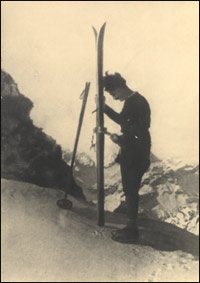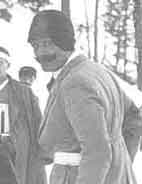Ottorino Mezzalama
Ottorino Mezzalama (born September 25, 1888 in Bologna , † beginning of February 1931 in the Valle di Rochemolles ) was an Italian mountaineer and, along with Luciano Roiti, is considered the pioneer of military ski mountaineering in Italy.
Life
Ottorino Mezzalama came to Turin with his parents on March 28, 1892 , where he made his first alpine experiences in his youth. He was close friends with the Swiss engineer Adolfo Kind and with Luciano Roiti, a lieutenant in the artillery unit, who in 1897 wrote his first treatise “Delle marce sulla neve” ( German “About marching on snow”) on the subject of military ski mountaineering dealt with the Italian Army . Together they became members of the Club Alpino Italiano (CAI) and founded the “Ski Club Torino”. After finishing school, he enrolled in the University's Faculty of Commerce and Economics, but was drafted into the artillery in 1909 . In 1912 he was during the Turkish-Italian War as Sergente to the Libyan appointed front and was awarded for it. After his discharge from military service, he continued his studies in 1913 and was able to pursue his hobby, mountaineering and then skiing, again.
First World War

In October 1915 Mezzalama was drafted into the 3rd Mountain Regiment ( 3 ° Reggimento Alpini ) as a reservist as part of the general mobilization of Italy during the First World War, together with his later friend, the mountaineer and mountain writer Piero Ghiglione . Due to the advanced studies he was promoted to sub- lieutenant, in 1916 to lieutenant and in 1917 to captain . During this time he was the technical director of troop ski training. His first course took place at the Little Saint Bernard , the second in the Valle di Champorcher of the Aosta Valley , followed by others in various Alpine areas of Italy outside the conflict regions. Particularly noteworthy is his larger than average backpack, which weighs 15 to 25 kg and which he always carried himself on ski tours and which he never gave to anyone else. This was where everything was stowed away that, in his opinion, he could ever need on his tours, because you never know what might surprise you in the mountains. You can only set the time of expiry, never definitely that of your return, as he said several times about his luggage. Around 3,000 "White Warriors from Adamello " for 26 ski units, divided into 13 battalions, were trained for ski-supported use until 1917. The 3 ° Reggimento Alpini was given the name “ Courmayeur ” in the same year .
Time after the First World War
After the end of the war, he finished his studies in Turin, where he lived with his mother. One of his big goals, which he set himself during his military service, was the ski exploration of the Alps, from the Maritime Alps to the Julian Alps , to describe them. In 1927 he took part in the first complete Italian Mont Blanc descent.
Avalanche accident in the Rochemolles Valley (1931)
When 20 soldiers of the 3rd Reggimento Alpini " Courmayeur " were missing after an avalanche in the Rochemolles valley above Bardonecchia , he volunteered in the search and rescue operation.
“... with his long, lanky gait, which never showed signs of fatigue or the difficulty of the ascent, he set off with all his equipment, making him like a tired soldier; just as often he calmly moved his eyes upwards and his twisted mustache gave his bare, dark face an almost old-fashioned touch of warmth. "
He and Mazzocchi were surprised by storms at the Bicchiere summit and were forced to spend three days in the icy cold "Elena" hut (today "Rifugio Gino Biasi" ). On the fourth day of the descent, both were exhausted when Mezzalama was caught in an avalanche and swept away. Mazzocchi searched in vain into the dark, and it was not until the next day that Mezzalama's lifeless body was found and recovered by helpers from the CAI Bolzano section .
The Mezzalama glacier in the Italian part of the Valais Alps , the Ottorino Mezzalama hut of the Club Alpino Italiano , the well-known Trofeo Mezzalama and the Mezzalama Skyrace are named after him.
literature
- Umberto Pelazza, Antonio Vizzi: Mezzalama Trophy - Myth and Reality 1933–1997. (English)
Web links
Individual evidence
- ^ Giuseppe Martelli: Il rifugio "Ottorino Mezzalama" - chi era Ottorino Mezzalama? (Italian), November 15, 2005.
- ↑ History and legend of the highest altitude alpine skiing in the world , website of the Trofeo Mezzalama.
| personal data | |
|---|---|
| SURNAME | Mezzalama, Ottorino |
| BRIEF DESCRIPTION | Italian ski mountaineer and pioneer of military ski mountaineering in Italy |
| DATE OF BIRTH | September 25, 1888 |
| PLACE OF BIRTH | Bologna , Italy |
| DATE OF DEATH | February 1931 |
| Place of death | near Rochemolles , Piedmont, Italy |
